Cabergoline: Uses, Side Effects, Interactions, Warnings & Dosing
Introduction
Cabergoline is an oral or injectable medication used to treat a variety of medical conditions. This medication is primarily prescribed for the treatment of hyperprolactinemia, a condition that results in high levels of the hormone prolactin in the body, which can cause infertility, lack of ovulation, and in women, abnormal breast milk production. Cabergoline can also be used to treat parkinsonism, an Acthoma, and other conditions. Some of the potential uses of this medication include the treatment of dopamine receptor agonists, certain types of neurological disorders, and some rare medical conditions.
Uses
Cabergoline is used to treat a variety of medical conditions, most notably hyperprolactinemia, parkinsonism, and acromegaly.
- Hyperprolactinemia: Cabergoline is a dopamine agonist that is used to reduce production of prolactin, the hormone responsible for controlling lactation in pregnant or breastfeeding women. High levels of prolactin can lead to infertility, lack of ovulation, and in women, abnormal breast milk production. Cabergoline helps restore prolactin levels to normal, allowing women to become pregnant and reduce the symptoms of abnormal breast milk production.
- Parkinsonism: Cabergoline is also used to treat parkinsonism, a neurological disorder that causes rigid, painful muscles and tremors, usually in the hands and feet. Cabergoline can help to reduce the severity of these symptoms, improving a patient’s quality of life.
- Acromegaly: This medication is also prescribed to treat acromegaly, a rare medical condition that causes excessive bone growth. Cabergoline is used to reduce the high levels of growth hormone which can lead to acromegaly.
- Dopamine Receptor Agonists: Cabergoline may be prescribed off-label to treat certain types of neurological disorders, such as restless leg syndrome, or other rare neurological conditions. In these cases, Cabergoline can help to relieve symptoms by stimulating dopamine receptors.
Side Effects
Like all medications, Cabergoline can cause side effects. The most common side effects of Cabergoline include dizziness, nausea, headaches, constipation, and anxiety or depression. Less common side effects may include stomach pain or cramping, chest pain, and stomach bleeding. In more rare cases, Cabergoline can cause heart valve problems.
Interactions
It is important to inform your doctor of any medications, supplements, or herbs you are taking before taking Cabergoline. Certain drugs may interact with Cabergoline and increase your risk of serious side effects. This medication may interact with medications used to treat depression, high blood pressure, or seizure disorders. Additionally, it may interact with certain antibiotics, steroids, anti-anxiety medications, and muscle relaxants.
Warnings
It is important to inform your doctor about any conditions you have before taking Cabergoline. This includes but is not limited to pregnancy, heart or kidney disease, and high blood pressure. Taking Cabergoline while pregnant can cause harm to the unborn baby, so it should be avoided in these cases. People with kidney or heart issues should only take this medication if absolutely necessary, under close medical supervision.
Definition
Cabergoline is an ergoline anti-dopaminergic drug, belonging to the class of medications called dopamine agonists. It acts by triggering the release of dopamine from the nervous system. This, in turn, reduces the activity of prolactin, a hormone primarily responsible for milk secretion during postpartum in lactating women. In addition to this, cabergoline is used to treat other medical conditions, including the following:
- Prolactinoma
- Parkinson’s Disease
- Restless legs syndrome
- Hyper or normoprolactinemia
- Hyper ornormoestrogenism
- Major depressive disorder (MDD)
- Antidepressant-induced hypersexuality disorder(AIHSD)
Dosage
Cabergoline is a dopamine receptor agonist, commonly prescribed as a therapy to treat several health conditions such as hyperprolactinemia, Parkinson’s Disease, major depressive episodes, and antidepressant-induced hypersexuality. This medication works by activating the dopaminergic pathways in the brain, thereby normalizing the dopamine levels. However, it is essential to correctly follow the dosage regimen in order to attain the desired therapeutic goals.
Cabergoline dosage will depend on the indication for which it is being prescribed. The dosage prescribed should be strictly followed as per the doctor’s instructions. Any changes should be consulted with the doctor beforehand. The recommended dosage for the common medical conditions that cabergoline is used to treat is as follows:
- Hyperprolactinemia: The initial recommended dose for cabergoline is 0.5 mg twice a week. This dosage can be gradually increased up to 2 mg twice a week over a period of several weeks. Patients may continue to receive this dosage up to 12 weeks. After 12 weeks, the dosage for cabergolineT can be reduced to 1 mg once a week.
- Parkinson’s Disease: The initial recommended dose for cabergoline is 0.5 mg twice a week. This dosage can be gradually increased up to 1 mg twice a week over a period of several weeks. Patients may continue to receive this dosage up to 12 weeks. After 12 weeks, the dosage for cabergolineT can be reduced to 0.5 mg once a week.
- Major Depressive Episode: The initial recommended dose for cabergoline is 0.25 mg once a week. This dosage can be gradually increased up to 0.5 mg once a week over a period of several weeks. Patients may continue to receive this dosage up to 12 weeks. After 12 weeks, the dosage for cabergoline may be increased cautiously to 0.75 mg once a week.
- Antidepressant-induced Hypersexuality Disorder: The initial recommended dose for cabergoline is 0.25 mg once a week. This dosage can be gradually increased up to 0.5 mg once a week over a period of several weeks. Patients may continue to receive this dosage up to 12 weeks. After 12 weeks, the dosage for cabergoline may be increased cautiously to 0.75 mg once a week.
It is important to note that cabergoline is not recommended for long-term use and should only be used for short-term therapy.
Conclusion
Cabergoline is a medication primarily used to treat hyperprolactinemia, parkinsonism, and acromegaly. It may also be prescribed off-label for certain types of neurological disorders and rare medical conditions. This medication can cause side effects such as dizziness, nausea, and headaches, and can also interact with certain medications. Patients should always discuss their medical history and any medications they are taking with their doctor before taking Cabergoline. Dosage of this medication is determined by the doctor, and can range from 0.5mg to 1mg for oral doses, and 0.25mg to 0.5mg for injectable doses.
Showing 1–16 of 18 results
-
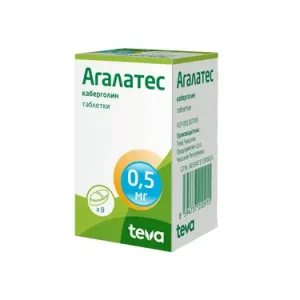
Agalates 0,5 mg (2 tab) TEVA
7,00 € Add to cart -
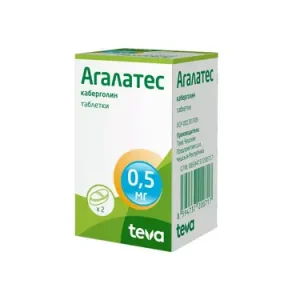
Agalates 0,5 mg (8 tab) TEVA
10,86 € Add to cart -

Bergolac 0,5 mg (2 tab) Veropharm LLC
5,00 € Add to cart -

Bergolac 0,5 mg (8 tab) Veropharm LLC
25,80 € Add to cart -
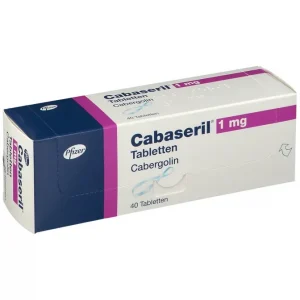
Cabaseril® 1 mg Pfizer
10,00 € Add to cart -
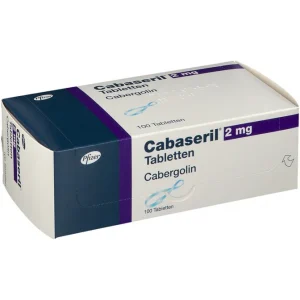
Cabaseril® 2 mg Pfizer
10,00 € Add to cart -

Cabergolin 0.5 mg (2 tab) Obninsk
4,00 € Add to cart -

Cabergolin 0.5 mg (8 tab) Obninsk
15,00 € Add to cart -

Cabergolin-ratiopharm® 0.5 mg
9,86 € Add to cart -
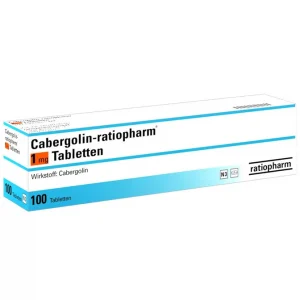
Cabergolin-ratiopharm® 1 mg
10,00 € Add to cart -
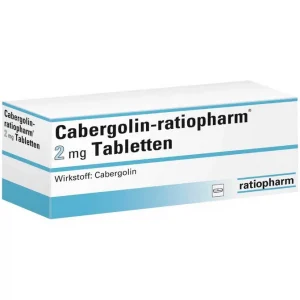
Cabergolin-ratiopharm® 2 mg
10,00 € Add to cart -

Cabergolin-TEVA® 0,5 mg
9,86 € Add to cart -

Cabergolin-TEVA® 1 mg
10,00 € Add to cart -

Cabergolin-TEVA® 2 mg Teva
10,00 € Add to cart -

Dostinex 0,5 mg (2 tab) Pfizer
9,00 € Add to cart -

Dostinex 0,5 mg (8 tab) Pfizer
22,75 € Add to cart